Article 81 of the Indian Constitution requires that each state receive Lok Sabha seats in proportion to its population and allocate those seats to constituencies of roughly equal size. However, the chronic unwillingness of the political class to reallocate seats in light of the country’s changing demographics has led to severe and entrenched malapportionment. In this piece, Vaishnav and Hintson explore this issue, and put forth potential solutions.
For over seven decades, India’s system of democratic federalism has been credited with holding the country together amid unparalleled ethnic, linguistic, and religious diversity. India’s post-independence constitution grants its subnational states significant powers over many aspects of day-to-day governance. Then in the mid-1950s, Indian states were reorganised on linguistic grounds, a farsighted political decision that defused many potential battles around linguistic identity.
If federalism is the glue that has kept the world’s largest democracy together, there are growing signs that this adhesive is becoming unstuck. The primary culprit is not relations between the Centre and the states, but disparities between the states themselves. For instance, the wealth gap between India’s states has exploded in recent decades; research by Praveen Chakravarty and Vivek Dehejia demonstrated that, as of 2017, India’s three richest states were three times richer than its three poorest states. Population growth has also been highly skewed. Thanks to falling fertility rates, India’s southern population is growing much more slowly than the northern population. Yet a large share of the central government’s allocation of resources to the states (via the apolitical Finance Commission) is still based on population figures from the outdated 1971 Census. Differences in wealth and demography fuel interstate migration, largely from poorer and younger northern states to more prosperous southern and western states. Collectively, these inequalities raise new questions about India’s federal design and create a potentially explosive wedge between the country’s leading and laggard regions.
In the recent general election, another troubling dimension of interstate inequality was bubbling beneath the surface: political representation. The chronic unwillingness of India’s political class to reallocate parliamentary seats in light of the country’s changing demographics has led to severe and entrenched malapportionment. As long as India’s politicians defer tough decisions on the legislative seats India’s states deserve, the current crisis of representation will only deepen.
Kicking the can down the road
Proportional representation is enshrined in India’s constitution, which governs the allocation of seats in the lower house of parliament, the Lok Sabha (or “House of the People”). Article 81 requires that each state receive seats in proportion to its population and allocate those seats to constituencies of roughly equal size. Proportional representation is not mandated for India’s centrally administered union territories (UTs) – parliament may decide their allotment of seats – or for states with a population below 6 million (as of the Thirty-First Amendment in 1973).
The constitution also regulates the total number of seats in the Lok Sabha. The Seventh Amendment (1956) capped the maximum number of elected seats at 520-500 from India’s states and 20 from its UTs. After adjustments under the Fourteenth Amendment (1962), the Thirty-First Amendment (1973), and the Goa, Daman and Diu Reorganisation Act (1987), the Lok Sabha now has a maximum sanctioned strength of 552 (530 from the states, 20 from the UTs, and two presidentially appointed members from the Anglo-Indian community). As of today, the Lok Sabha has a maximum of 545 representatives filling these seats.
To divide these seats proportionally, Article 82 of the constitution calls for the reallocation of seats after every census based on updated population figures. However, the Forty-Second Amendment enacted in 1976 – during the 21-month Emergency rule by then Prime Minister Indira Gandhi – suspended the revision of seats until after the 2001 Census. One impetus for the freeze was Gandhi’s desire to promote family planning policies by ensuring that states that managed to lower their fertility rates (and, hence, limit their population growth) would not be punished.
In 2002, parliament delayed reallocation even further, passing the Eighty-Fourth Amendment and extending this freeze until the next decennial census after 2026 (which will take place in 2031). However, the Eighty-Seventh Amendment (2003) did allow for redistricting within states based on 2001 population figures, although the total number of seats assigned to each state could not be altered.1 By 2031, the population figures used to allot parliamentary seats to each state will be six decades old.
This unwillingness to acknowledge India’s changing demographics has come at a cost. Indian states have grown at drastically different rates over the past 40 years, a product of disparate – albeit slowly converging – fertility rates (see Figure 1). States with slow population growth, such as the southern states of Kerala and Tamil Nadu, argue that they should not be punished for curbing population growth more effectively than states with ballooning populations, such as the northern states of Bihar and Uttar Pradesh. The northern states, in turn, argue that they have been shortchanged; after all, the notion of “one person, one vote” is a central tenet of democratic representation.
Figure 1. Fertility rates in selected Indian states, 2001-2016
Unable to resolve this dispute, successive generations of Indian politicians have chosen instead to delay reallocation rather than reckon with its explosive implications for parliamentary representation.
How bad is India’s malapportionment?
The ultimate outcome of this persistent deferral is severely unequal representation. Malapportionment was already serious by 2001, when politicians moved to delay seat readjustment for a second time. Writing then, political scientist Alistair McMillan documented just how drastic over- and underrepresentation had become. According to the 2001 Census, for instance, McMillan calculated that Tamil Nadu should have had seven fewer Lok Sabha seats, while Uttar Pradesh should have gained seven more.
Updating McMillan’s calculations to incorporate 2011 Census figures reveals even starker disparities. Following McMillan, we calculate each state’s number of seats using the Webster method, a standard formula proven to provide an unbiased allocation of seats.2 Then, using the 2001 and 2011 Censuses, we project state population figures out to 2026 and repeat this calculation, illustrating the severity of malapportionment by the time the freeze on reapportionment expires.3 Table 1 displays the revised seat counts for each state. Because the state of Andhra Pradesh was bifurcated (into Andhra Pradesh and Telangana) in 2014, the analysis aggregates these states.
Table 1. Malapportionment in the Lok Sabha, 2011 (actual) and 2026 (projected)
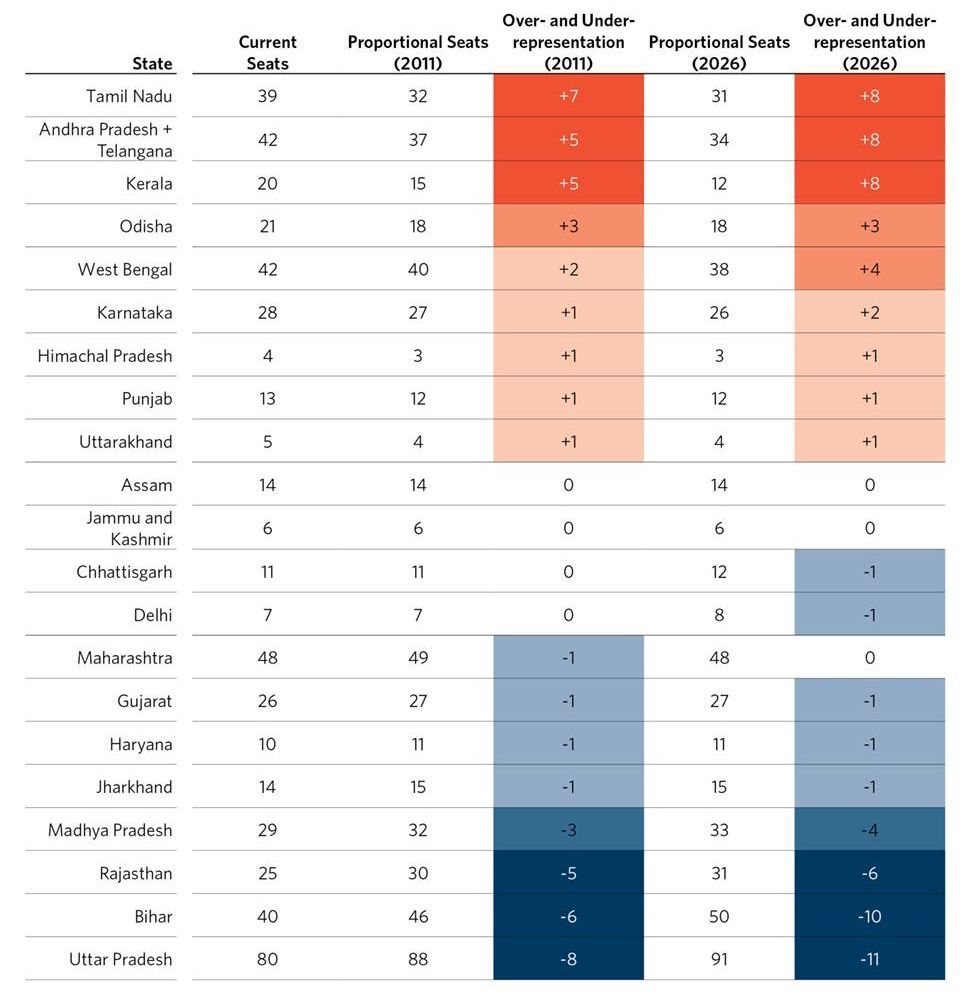
Sources: Election Commission of India; Office of the Registrar General, 2006; and authors’ calculations.
Note: The number of seats each state merits is calculated using the Webster method, which is described in the text.
These updated numbers cause sizable shifts in political power. Four north Indian states (Bihar, Madhya Pradesh, Rajasthan, and Uttar Pradesh) would collectively gain 22 seats, while four southern states (Andhra Pradesh, Kerala, Telangana, and Tamil Nadu) would lose 17 seats. Based on our population projections, these trends will only intensify as time goes on. In 2026, for instance, Bihar and Uttar Pradesh alone stand to gain 21 seats while Kerala and Tamil Nadu would forfeit as many as 16.
A hidden consequence of reapportionment is the change in the number of seats constitutionally reserved for Scheduled Caste (SC) and Scheduled Tribe (ST) candidates. The number of SC- and ST-reserved seats is determined on a state-by-state basis: the share of each state’s seats reserved for SC and ST candidates must match those communities’ share of the overall state population. Reapportionment affects SC- and ST-reserved seats in two ways: by updating the population shares of SC and ST communities in each state (last done in 2008), and by updating the total number of seats for each state (which has stayed constant since 1971).
Revising both of these numbers to match 2011 Census figures would not have a large effect on the total number of reserved seats: there would be one more ST-reserved and two more SC-reserved seats. Beneath the modest change lies a discernible regional shift: slower-growing southern states would lose reserved seats while faster-growing northern states would gain them. All told, the reservation status of 18 seats would change.
Reimagining the 2014 elections
Unsurprisingly, reapportionment carries profound implications for political parties. Parties with bases concentrated in fast-growing northern states – like the current ruling Bharatiya Janata Party (BJP) – would gain power at the expense of southern regional heavyweights. To illustrate, we simulate the impacts of reapportioning seats on the basis of the 2011 Census on the 2014 Lok Sabha election results. Assuming that the proportion of seats in each state won by each party does not change, the BJP’s majority would have increased from 282 to 299, largely at the expense of southern regional parties (see table 2).
Table 2. Simulating the 2014 Lok Sabha results after adjusting for malapportionment
Misrepresentation in theory and practice
While these dramatic shifts in seats held by each state suggest acute misrepresentation, the extent of the problem greatly depends on the chosen unit of analysis. This is because the number of citizens in a constituency does not perfectly correlate with the number of registered or actual voters in that constituency. Northern states tend to have low levels of voter registration, in part because they have a disproportionate share of young residents below the voting age of 18. But these states also have historically exhibited lower turnout among registered voters. The southern states, by contrast, tend to have high levels of political engagement in terms of both voter registration and turnout.5 Thus, states that are overrepresented (or underrepresented) due to their total population may not be in terms of registered or actual voters.
Consider the average number of citizens, registered voters (also called “electors”), and actual voters per member of parliament (MP) in Uttar Pradesh, the most underrepresented state, versus Tamil Nadu, the most overrepresented (see Figure 2). While MPs in Uttar Pradesh cater to nearly 3 million residents on average, compared to 1.8 million in Tamil Nadu, the number of registered voters per constituency is similar. Incredibly, slightly more voters per constituency went to the polls in Tamil Nadu than in Uttar Pradesh in 2014. This finding suggests that while citizens might ‘count less’ in states with parliamentary underrepresentation, the same is not necessarily true of actual voters.
Figure 2. Representation per MP in Tamil Nadu and Uttar Pradesh
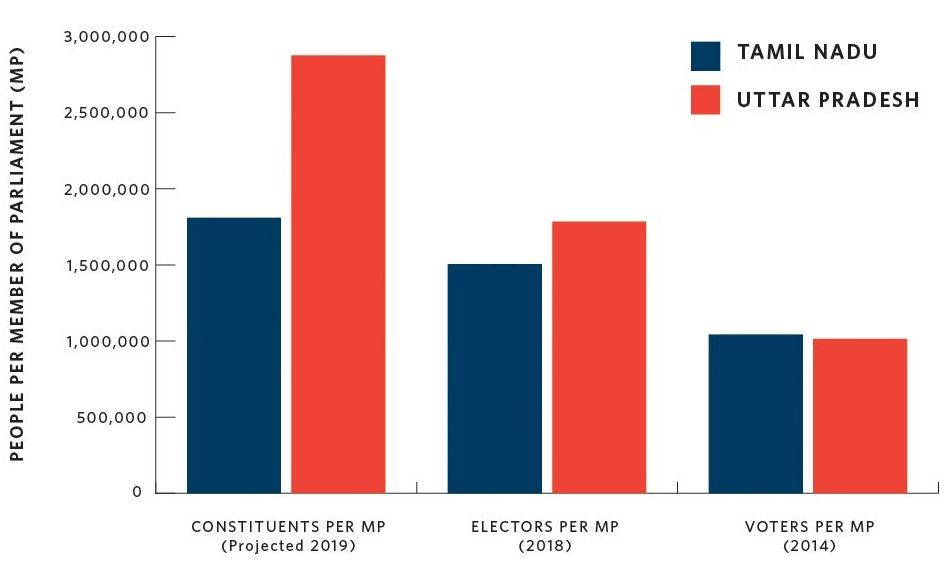
Sources: Election Commission of India; Office of the Registrar General, 2006; and authors’ calculations.
Possible solutions
Barring another constitution amendment, parliamentary seats will not be reallocated until after the 2031 Census. However, this fact should not delay a comprehensive federal discussion of the various dimensions of interstate inequality, including the tricky issue of representation. What solutions might policymakers envision?
The first strategy is simply committing to a reallocation after 2031 and resisting the urge to kick the can down the road once more. This is the ‘pulling off the Band-Aid’ strategy: the longer the process drags on, the more pain will eventually be felt. Had India reallocated seats after each decennial census, the composition of the Lok Sabha would have changed gradually over time. After decades of self-imposed inertia, any future reapportionment will inevitably induce abrupt changes in the balance of political power.
Another solution, which has also been proposed by McMillan, is to increase the number of seats in the Lok Sabha. This has two clear advantages. First, increasing the number of MPs would address the ballooning size of constituencies, which hamstrings MPs’ responsiveness to constituents’ needs. At present, Indian parliamentarians answer to vastly larger sums of people than their counterparts in literally every other democracy: Indian MPs represent an average of 2.5 million citizens – over three times the number represented by members of the House of Representatives in the United States, which ranks second (see Figure 3).
Figure 3. Top 10 countries with the largest representation ratios
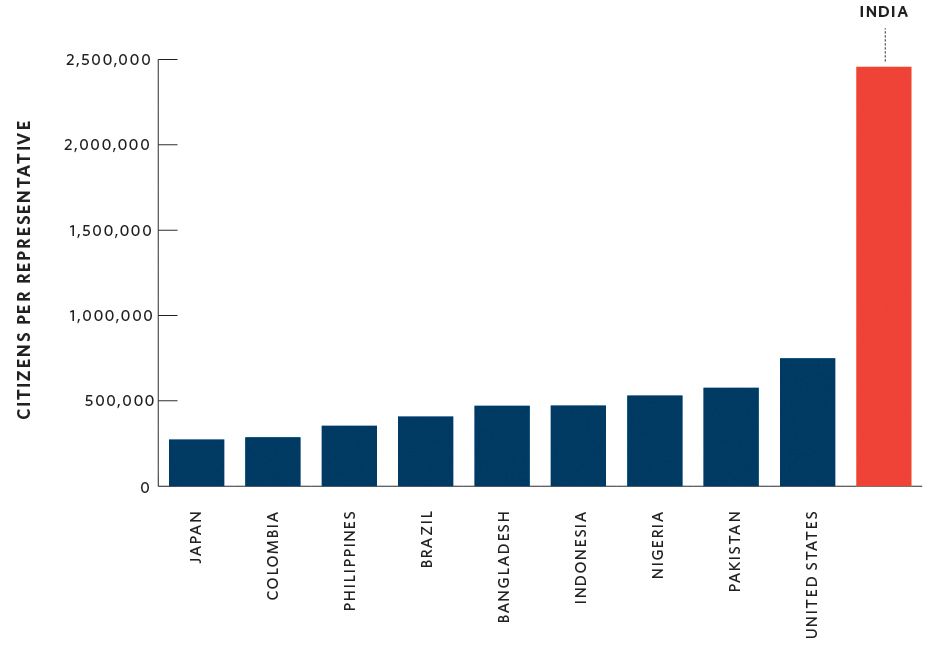
Sources: Inter-Parliamentary Union (for house sizes), 2019; and World Bank (for populations), 2019.
Notes: Sample restricted to countries Freedom House defines as free or partly free. Lower houses include unicameral bodies.
Expanding the size of the house may also be more politically feasible than reapportioning the current number of seats. After all, representatives inherently question any arrangement that takes seats away from their state (which potentially places their own job on the chopping block) but may be less opposed to adding more seats. McMillan proposes that the Lok Sabha expands just enough that the most overrepresented state does not lose any seats under reapportionment. Using the Webster method and 2001 Census figures, he calculates that the Lok Sabha would have to expand from 545 to 668 members for this to occur (not adjusting the 21 seats constitutionally exempt from proportional representation).
As malapportionment has worsened, the additional seats the Lok Sabha must add to prevent any state from losing seats have swelled. To reflect 2011 Census figures, states subject to proportional representation would need to have a combined 697 seats (compared to 524 now), for a total Lok Sabha size of 718. When projected to 2026, the picture is even starker. If no state is to lose representation, the Lok Sabha would have to consist of 848 representatives, exceeding the maximum strength of any lower house or unicameral body in a democratic country today (see Figure 4).
Figure 4. Top 10 countries with the largest lower houses
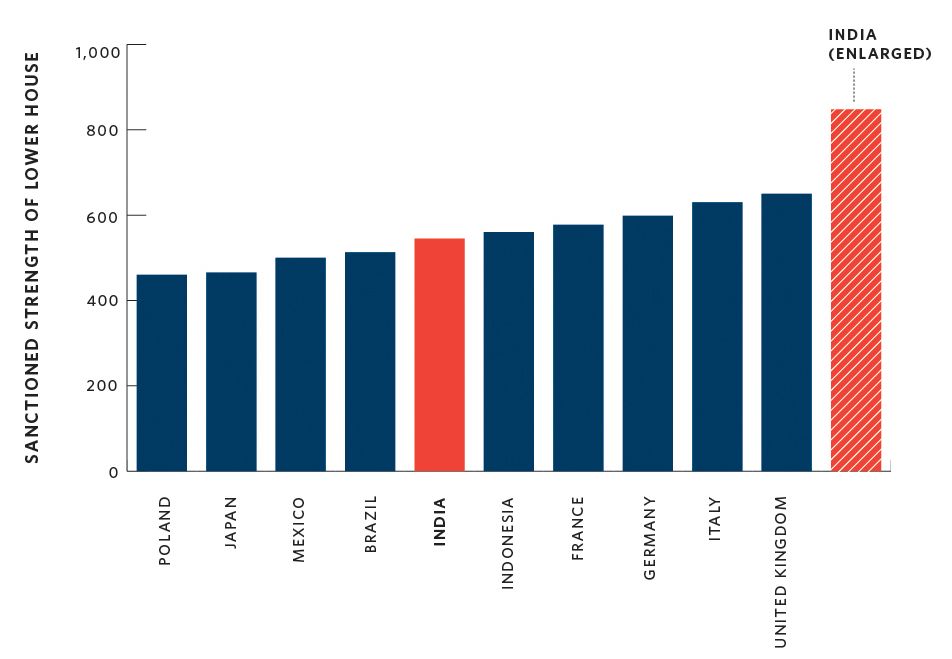
Source: Inter-Parliamentary Union, 2019.
Notes: Sample restricted to countries Freedom House defines as free or partly free. Lower house includes unicameral bodies.
Under this proposal, Uttar Pradesh would have a whopping 143 seats, while Kerala’s parliamentary delegation of 20 would remain unchanged (see Figure 5).
Figure 5. Expanding the Lok Sabha using 2026 population projections
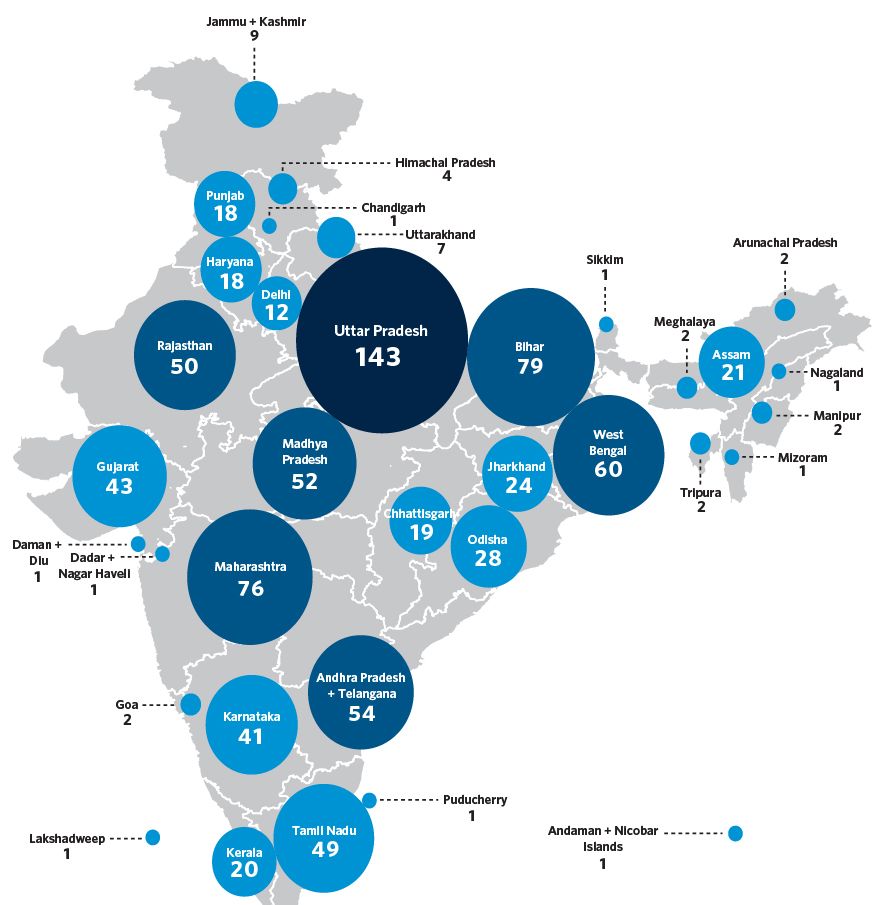
Source: Office of the Registrar General, 2006; and authors’ calculations.
Note: Calculations use projected population figures while ensuring no state loses seats during reapportionment.
A third solution is reforming the composition of the Rajya Sabha. This “Council of States” is India’s upper house of parliament and – as its name suggests – offers a venue for states to advocate their interests. As with the Lok Sabha, upper house seats are allocated to states in proportion to their population, with the constitution setting a maximum ceiling of 250 seats. Unlike the directly elected Lok Sabha, however, state legislative assemblies select Rajya Sabha MPs.6 While Rajya Sabha members theoretically advocate for their own states, a 2003 amendment broke the link between a representative and his or her state by eliminating an earlier “domicile requirement”, which had mandated MPs be residents of the state they represent. In the absence of any residency requirement, political parties can nominate virtually any candidate to a vacant Rajya Sabha seat without regard for the candidate’s geographic home.
Fixing the domicile issue will only go so far, however. Even before the 2003 legislative change, Rajya Sabha MPs got around the requirement by obtaining a local address (recall that Manmohan Singh, former Congress Party Prime Minister from 2004 to 2014, first joined the Rajya Sabha in 1991 from the state of Assam, to which he had no prior connection). An additional change worth considering is ending the indirect election of Rajya Sabha members and instituting a process of direct election. The United States adopted this approach with the Seventeenth Amendment (ratified in 1913), which introduced the direct election of US senators as opposed to leaving their selection to state legislatures. An even more radical measure would involve moving toward a fixed number of seats for each state (again, like the US Senate, where every state has two senators – irrespective of population size). Transforming the upper house into a real venue for debate of states’ interests could potentially soften the opposition to a reallocation of seats in the lower house.
Irrespective of the route pursued, the debate on India’s representational future should not be delayed any further. A strong argument can be made that any such conversation should be part and parcel of a larger negotiated federal compact between the Centre and the states that would address issues of taxes, fiscal allocations, migration, and other concerns of interstate inequality. To miss this opportunity would risk inflicting further damage to India’s federal design – a vital, albeit imperfect, element of India’s democratic longevity.
This piece is part of the “India Elects 2019” series, a collaboration between Carnegie and the Hindustan Times, and has been reprinted from www.carnegieendowment.org: https://carnegieendowment.org/2019/03/14/india-s-emerging-crisis-of-representation-pub-78588. The authors are grateful to Samuel Brase for editorial assistance and to Jocelyn Soly for graphic design help. We thank Apoorva Jadhav for advice on population projections.
Notes:
- In other words, states could internally redraw electoral constituencies to ensure their roughly equal size. However, there would be no changes to the numbers of seats assigned to states.
- The Webster method proceeds as follows: divide the number of seats in the house by the total population. Then divide each state’s population by this ‘divisor’, rounding to get the proportional number of seats for each state. If, after rounding, these seats add to more (or less) than the total number in the house, increase (or decrease) the divisor until the rounded seat numbers for each state add to the desired amount.
- After the publication of the 2001 Census, the Government of India produced population projections from 2006 to 2026. However, the 2011 Census revealed many of the state-level projections to be inaccurate, although the total national population projection for 2011 was very close to the actual number (1.20 and 1.21 billion, respectively). Leveraging this fact, we keep the national projected population figure for 2026 and project state populations such that they sum to this total. We employ a non-cohort-component projection with logistic state growth rates from 2001 to 2011, as outlined in this tool developed by the United States Census Bureau: https://www2.census.gov/software/sptoolkit/documentation/salgst-methods.pdf.
- Under the constitution, parliamentary seats are reserved for SCs and STs, two historically disadvantaged communities. SCs (or Dalits) occupy the bottom rung of the Hindu caste order, while STs (also called Adivasis) are India’s tribal population. In reserved constituencies, candidates must hail from the reserved group (either SC or ST) in order to contest elections. However, there are no restrictions on the electorate. In other words, all eligible voters –irrespective of community – are allowed to cast their ballots.
- For instance, according to the 2011 Census, 28.6% of Tamil Nadu’s population was below the age of 18, compared to 42.7% of Uttar Pradesh’s population. Partially as a result of demographic differences, there are vast differences in the percentage of residents registered to vote in the two states (83.3% in Tamil Nadu versus 62.1% in Uttar Pradesh). Finally, even among registered voters, there are stark voter turnout disparities between the two states: 73.7% in Tamil Nadu compared to 58.3% in Uttar Pradesh in the 2014 election.
- Rajya Sabha MPs serve six-year terms and elections are held biennially, with one-third of seats up for election every two years.




 29 May, 2019
29 May, 2019 




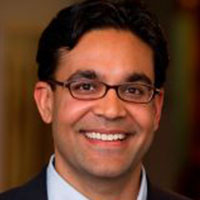
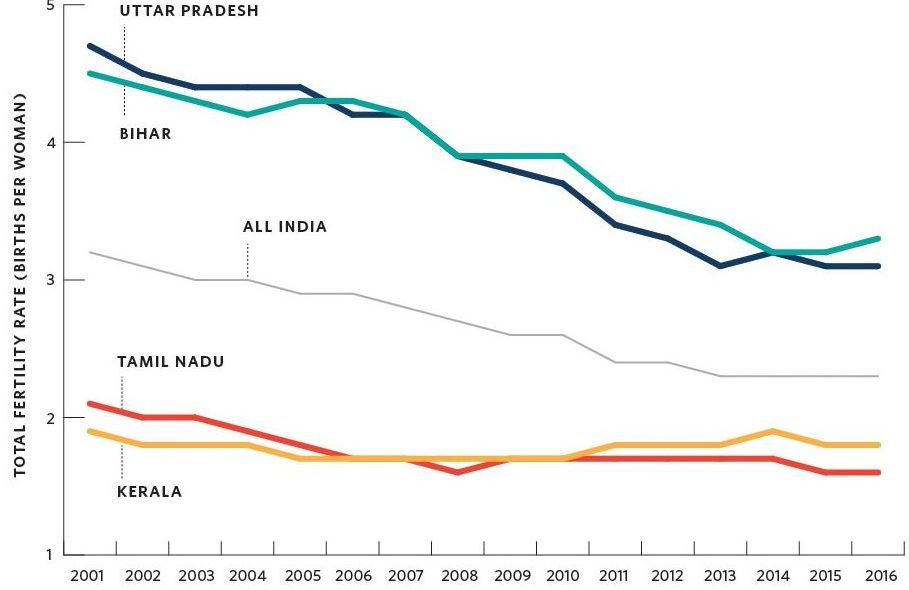
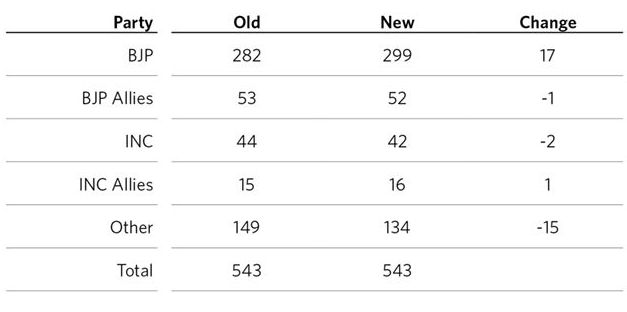
By: Subhash Athale 22 March, 2022
The states should get representation in proportion to the square root of their adult population or of the number of voters. The total number of representatives in the parliament should remain the same as ar present.